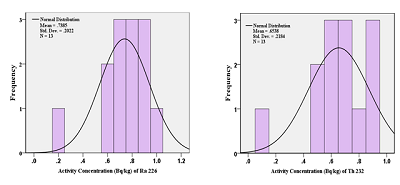


Indian Journal of Science and Technology
DOI: 10.17485/IJST/v13i15.149994
Year: 2020, Volume: 13, Issue: 15, Pages: 1546-1554
Original Article
M A Salama1,2*, M H M Salama2
1Deanship of Common First Year, Jouf University, Sakaka, KSA
2Nuclear and Radiological Regulatory Authority, Cairo, Egypt
*Corresponding author
M A Salama
Deanship of Common First Year, Jouf University, Sakaka, KSA.
Nuclear and Radiological Regulatory Authority, Cairo, Egypt.
Email: [email protected]
Received Date:13 March 2020, Accepted Date:27 April 2020, Published Date:04 June 2020
Objectives: The present work was designed to determine radionuclide and heavy metal concentrations in tap water of the eastern Nile Delta and to investigate its validity for human consumption. Methods: Thirteen samples of tap water were collected from Dakahlia governorate and analyzed for selected chemical and radionuclide constituents. The concentrations of heavy metals (iron (Fe), cobalt (Co), nickel (Ni), manganese (Mn), zinc (Zn), lead (Pb), cadmium (Cd), chromium (Cr) and copper (Cu)) and radionuclides (232Th, 40K and 226Ra) were determined. Determination of heavy metal concentration was carried out by Inductively Coupled Plasma Atomic Emission Spectrometer (ICPAES). Whilst, the radionuclide measurements were conducted using Hyper Pure Germanium Detector (HPGe) Gamma-Ray Spectrometry. Findings: Results of this work indicated that Dakahlia tap water is slightly alkaline to alkaline water, with low salinity ranging from 233 ppm to 323.7 ppm. The heavy metal concentrations in tap water are below the permissible level for drinking. However, an anomaly of Co content (0.015 ppm) is detected in Aga site. Statistical analysis showed a strong correlation between every couple of sampling sites, but the correlation of Aga site with the rest of the sites was weak. Also, weak correlations among the heavy metals contents were detected. The maximum activity concentrations were 1.0 Bq/l, 0.9 Bq/l, and 2.6 Bq/l for 226Ra, 232Th, and 40K, respectively. Such values are less than the international limits recommended for water consumption. Multivariate statistical ways were also used to define the existing correlation between radionuclides and radiological health risk parameters and to pinpoint the maximum contribution of radionuclide in radioactivity. A strong correlation between every couple of sampling sites is existed, however, the correlation of Aga site with the other sites was weak. The estimated values of risk indices were below the international recommended levels. Application: Accordingly, the tap water of Dakahlia governorate is considered safe for human consumption except for Aga site. The exceptional water should be infiltrated before consumption to remove the excess of Cr content. The outcome of this research may be advantageous to t3.3he water database of Dakahlia governorate.
Keywords: Heavy Metals; Natural Radioactivity; Statistical Analysis; Radiation Hazard Indices; Tap Water; Eastern Nile Delta; Egypt
© 2020 Salama, Salama. This is an open-access article distributed under the terms of the Creative Commons Attribution License, which permits unrestricted use, distribution, and reproduction in any medium, provided the original author and source are credited.
Published By Indian Society for Education and Environment (iSee)
Subscribe now for latest articles and news.